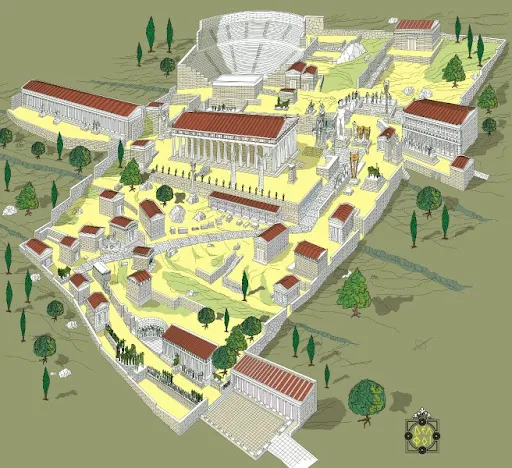Delphi - the Marathon victory ex-voto of the Athenians
8) Ex-voto of the Athenians to commemorate their victory at Marathon
Period: approx. 460 B.C.
The monument is comprised of 13 statues created by Phidias, during approx. 456 B.C.
The precise location of the monument is not specified. Based on the archaeological findings and the claim by Pausanias that he have seen it "under the Trojan Horse".
It can be concluded that the Ex-voto of the Athenians would had been found along the path of the Sacred Way. Just behind it, would be standing on a highest pedestal the bronze Trojan Horse. A total of sixteen bronze statues were included, depicting a movement which connected them all towards the direction of the Sacred Way.
According to Pausanias, the thirteen statues were works of the then young Phidias. The statue of victorious Miltiades stood between those of Apollo and Athena together with the statues of the mythical heroes and kings of Athens: Codrus, Theseus, Phileus (perhaps Neleus or Menestheas). Another seven famous athenaean heroes of the old Athenian tribes continued in the same line.
The monument was dedicated much later to the Battle of Marathon, during the years of Cimon, Miltiades' son, around 460 B.C., when Athens wanted to rectify the injustice that had been done to the glorious victor who died as a prisoner in jail.
None of these early classical period works were found in Delphi. However, in 1972, two exceptional pieces of artwork -2 bronze statues- that were recovered from the bottom of the sea near the ancient Regio of Calabria in Sicily, were attributed to this monument. It is believed that the statues depict a hero from one of the old Athenian tribes and either Miltiades of Phileus. All special votive offerings were dedicated to the Tithe after the victories against the Spartans, at Oinoi (460 B.C.), at Thyrea (414 B.C.) and at Leuktra (371 B.C.), and included about 30 bronze statues and groups.
With this offering Athens seeks 1) its connection with its mythical ancestors and heroes, the mythical expeditions and the Trojan War, 2) to perpetuate its glory and to strengthen its ties with Thebes, after the victory with Epameinondas, but also 3) to overshadow Sparta's votive.
support us - buy the map!

The reconstruction poster map of Delphi,
by the Archaeological Guide of Greece
Poster size: 85X56cm / 34X22in
Designed and produced for a convenient and handy use in site and at home, it will assist you to visualize the Sanctuary of Apollo, where theOracle of Delphi was, the Ancient Theater, the Stadion, the Gymnasion of Delphi and the Sanctuary of Athena Pronaia.
price: 20€



